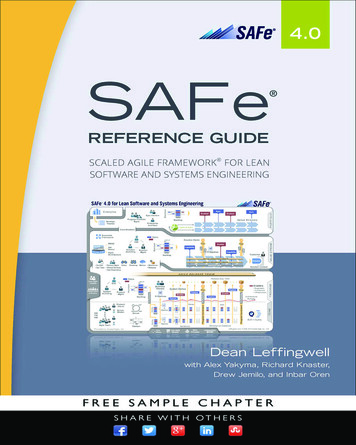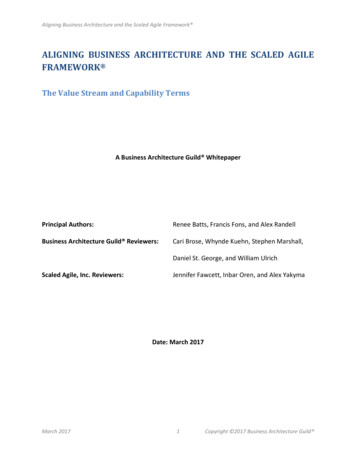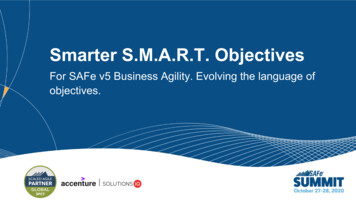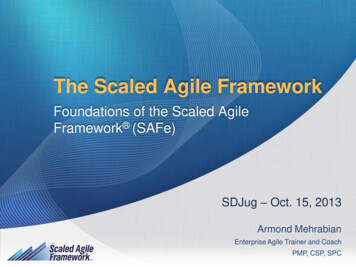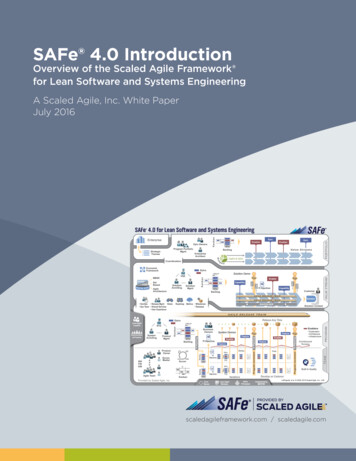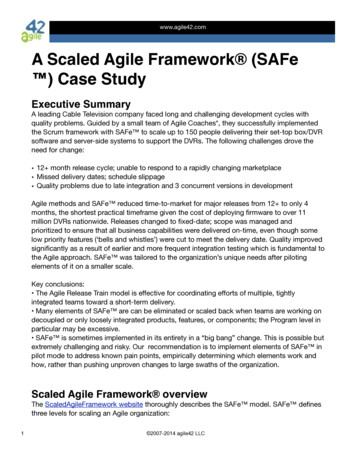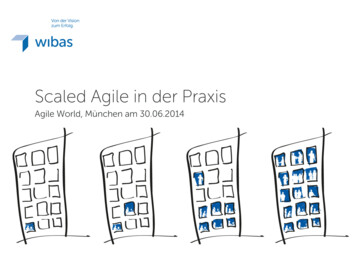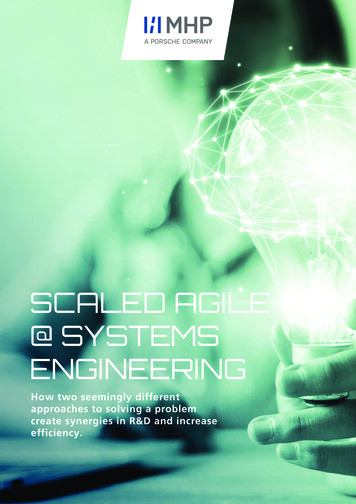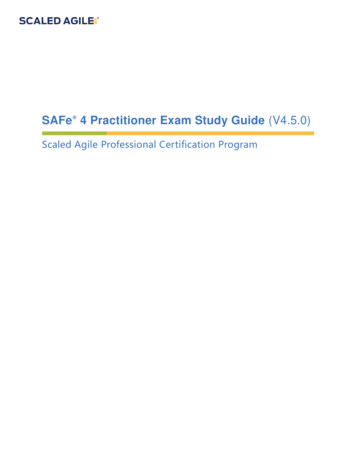
Transcription
SAFe 4 Practitioner Exam Study Guide (V4.5.0)Scaled Agile Professional Certification Program
Table of ContentsWelcome to Role-Based Learning! . 3About This Study Guide . 3Preparing for the Exam . 3Exam Details. 3Course Attendance . 4Certification Role – SAFe 4 Certified Practitioner . 4Key Areas of Competency . 4Prerequisite Skills and Knowledge. 4Target Candidate (Qualifying Standard: 5 Levels of Competency) . 4Exam Objectives Overview . 5Exam Objectives: Sections, Tasks, and Subtasks . 5SAFe 4 Practitioner Exam Objectives . 5Reading and Reference List for Exam . 12Scaled Agile Website Resources . 12Scaled Agile Download Resources . 13Required Books . 13Search the Scaled Agile Framework Site . 13Sample Test . 13Practice Test . 14Learning Journey: Check List. 14Thank You - Subject Matter Experts . 14SAFe 4 Practitioner Exam Study Guide (V4.5.0) 06.2017-2- Scaled Agile, Inc.
Welcome to Role-Based Learning!Scaled Agile’s role-based offerings focus on the skills, knowledge, and experience required tosuccessfully perform the job. As part of your SAFe learning journey we encourage you to attendtraining, read recommended books and articles, take advantage of videos and enablement, gainsome real-world experience in the role, and then take the exam.About This Study GuideThis study guide is designed to provide relevant and content-specific exam information such as thecertification role description, prerequisite skills and knowledge, exam objectives, and acomprehensive reading list. Reviewing this study guide does not guarantee success on the exambut it will provide guidance on your journey to become SAFe certified.The sections in this study guide map to the course. There is additional information in this studyguide around the certification role that has been defined by our subject matter experts (SMEs).Preparing for the ExamCongratulations on taking the first step towards becoming part of a growing community of SAFecertified professionals!Preparation Course AttendanceRequired / RecommendedRequired Exam Study Guide Certification Role Description Prerequisite Skills/Knowledge Target Candidate Standard Exam Objectives Reading List Sample TestRecommended Practice TestRecommended ExamRequiredRecommendedAccessClassroom Training:SAFe for TeamsLearning Plan in the SAFeCommunity PlatformOn SAI website: SAFe forTeams course pageLearning Plan in the SAFeCommunity PlatformLearning Plan in the SAFeCommunity PlatformExam DetailsInformation such as number of questions, time on exam, and exam format can be found under“Exam Details” at: www.scaledagile.com/safe-for-teams/.SAFe 4 Practitioner Exam Study Guide (V4.5.0) 06.2017-3- Scaled Agile, Inc.
Course AttendanceThe first step towards becoming a SAFe Certified Professional is to attend the SAFe for Teamstraining class. Course attendance is required (all days) and completion provides access to the examwhich is part of the complete SAFe Learning Plan. A complete list of courses, including dates andlocations, is on the Scaled Agile website.Please note that attending the class does not guarantee passing the exam. Please take the time toreview the materials covered in this study guide.Certification Role – SAFe 4 Certified PractitionerA SAFe 4 Certified Practitioner (SP) is a SAFe team member responsible for using Scrum,Kanban, and XP in a SAFe environment. Key areas of responsibility include planning ProgramIncrements and Iterations, breaking requirements into Stories, developing incrementally with built-inquality, demoing value at a Team and Program level, and problem-solving impediments to driverelentless improvement.Key Areas of Competency Explain SAFe Agile Principles Plan Iterations Plan Program Increments Execute Iterations and demonstrate value Improve Agile Release Train processes Integrate and work with other teams on the Agile Release Train Perform as member of an Agile team on an Agile Release TrainPrerequisite Skills and Knowledge Familiarity with Agile concepts and principles Familiarity with Scrum, Kanban, and XP Working knowledge of software or hardware development processesTarget Candidate (Qualifying Standard: 5 Levels of Competency)This job role is defined as part of the Job Task Analysis and is based on a standardized 5 levels ofcompetency. Candidates who pass this exam have met this qualifying standard and candemonstrate knowledge or perform skills at the designated level below:1 - [Beginner] Minimal knowledge or experience2 - [Novice] Some knowledge or experience with assistance3 - [Proficient] Capable of performing tasks with some assistance SAFe 4 CertifiedPractitioner4 - [Advanced] Fully competent in performing tasks with little assistance5 - [Expert] Content developer or contributor with no assistanceSAFe 4 Practitioner Exam Study Guide (V4.5.0) 06.2017-4- Scaled Agile, Inc.
Exam Objectives OverviewThe first step in developing role-based curriculum is to conduct a Job Task Analysis (JTA)workshop where a group of subject matter experts (SMEs) work together to define the tasks, skills,and knowledge related to a specific job role. The JTA creates the foundation for the examobjectives and competency standard which serve as the basis for the exam. The output of the JTAincludes: key areas of competency, prerequisite skills and knowledge, the candidate qualifyingstandard, and a comprehensive list of objectives and tasks related to the job role.Scaled Agile SMEs use these objectives to develop exam questions. It is recommended you reviewthese objectives and ask yourself: Do you know how to complete the tasks in the objective? Are youfamiliar with the terms and concepts? Do you know the outcome of NOT performing the taskscorrectly (anti-patterns)? Most objectives are covered on the exam so be sure to review thematerials.Exam Objectives: Sections, Tasks, and SubtasksSections are the main job role topics identified during the JTA process. Tasks that are related toeach section are grouped under each section and are made up of subtasks which are the actions orsteps to complete the task. Example:SECTION HERE1.11.1.1TASK HERESUBTASK HEREThe objectives specific to this exam begin below and map to the course materials either at a highlevel or in some cases with more detail.SAFe 4 Practitioner Exam ObjectivesSECTION 1: Introducing the Scaled Agile Framework 1.1Connect with SAFe and the SAFe Configurations1.1.1Have a basic understanding of SAFe1.1.2Define an Agile Team1.1.3Define an Agile Team of Teams1.1.4Coordinate Large Value Streams1.1.5Define purpose and intent of an Agile PortfolioSAFe 4 Practitioner Exam Study Guide (V4.5.0) 06.2017-5- Scaled Agile, Inc.
1.2Explore Lean, the Agile Manifesto, and SAFe Principles1.2.1Describe SAFe House of Lean1.2.2Describe the Agile Manifesto1.2.3Describe how Agile impacts development (Waterfall vs Agile)1.2.4Outline the SAFe Lean-Agile Principles1.2.5Describe the Principles as they relate to the SAFe Practitioner role (Focus onprinciples #1, #2, #3, #4, #7, #8, #9)1.2.6Describe the differences and impacts of small batch pull versus large batch pull1.3Identify Scrum, Kanban and Extreme Programming (XP) Practices1.3.1Compare traditional development to Agile regarding teams, requirements, and valuedelivery1.3.2Identify the three roles on Agile Teams (Development Team, Scrum Master, ProductOwner)1.3.3Define Kanban and describe the benefits of a Kanban board1.3.4Define Kanban and describe the benefits of an XP environment1.3.5Describe how SAFe Teams are part of an Agile Release TrainSECTION 2: Building an Agile Team2.1Build Your Team2.1.1Describe aspects of an Agile Team2.1.2Describe the flow of value in Agile2.1.3Define the benefits of cross-functional Agile Teams2.1.4Define the benefits of collocated teams2.1.5Describe each Agile Team role: Development Team, Product Owner, Scrum MasterSAFe 4 Practitioner Exam Study Guide (V4.5.0) 06.2017-6- Scaled Agile, Inc.
2.1.6Define the purpose and role of the System Team2.1.7Describe the benefits of organizing teams around value2.1.8Compare Feature Teams and Component Teams2.2Explore the Scrum Master and Product Owner roles2.2.1Describe the role of the Scrum Master within the Enterprise2.2.2Describe the role of the Product Owner within the Enterprise2.3Meet the Teams and People on the Agile Release Train2.3.1Describe an Agile Release Train and its purpose2.3.2Describe the Agile Release Train roles: Release Train Engineer, ProductManagement, and System Architect/EngineerSECTION 3: Planning the Iteration3.1Prepare the Backlog3.1.1Define Solution Features for the Program Backlog3.1.2Identify Features benefits and acceptance criteria3.1.3Describe the Team Backlog3.1.4Define User Stories and the 3 Cs3.1.5Describe the purpose of "INVEST" in User Stories3.1.6Define the three types of Enabler Stories3.1.7Describe how to split Features and Stories3.1.8Describe purpose and benefits of Acceptance criteria3.1.9Estimate Stores with relative Story pointsSAFe 4 Practitioner Exam Study Guide (V4.5.0) 06.2017-7- Scaled Agile, Inc.
3.1.10 Describe how Estimating Poker can be effective in estimations3.1.11 Explain the benefits of "whole team" estimation3.1.12 Describe how to sequence Stories3.1.13 Describe the purpose and benefits of capacity allocation3.2Plan the Iteration: Purpose, Process, Result, Commitment3.2.1Explain the four steps of Plan and Commit: Purpose, Process, Result, ReciprocalCommitment3.2.2Describe how Iteration Planning should flow3.2.3Explain how size can be used to estimate duration3.2.4Describe ways to establish velocity when historical data does not exist3.2.5Describe the purpose of Iteration Goals3.2.6Perform story analysis and estimation3.2.7Describe ways a team can commit to Iteration Goals3.2.8Describe how iteration Planning works for Kanban teamsSECTION 4: Executing the Iteration4.1Visualize the Flow of Work4.1.1Identify the steps to complete a Story4.1.2Set Work-In-Process (WIP) Limits4.24.2.14.3Measure the Flow of ValueTrack status with charts (e.g. Burn-up charts, Cumulative Flow Diagrams)Build In QualitySAFe 4 Practitioner Exam Study Guide (V4.5.0) 06.2017-8- Scaled Agile, Inc.
4.3.1Describe the benefits of building quality into work4.3.2Define emergent design and intentional architecture4.3.3Describe Architectural Runway4.3.4Describe ways to perform continuous system integration4.3.5Describe benefits of test automation4.3.6Explain the benefits of and reasons for refactoring4.3.7Explain the benefits of pair work4.3.8Explain the benefits of collective ownership4.3.9Describe Model-Based Systems Engineering (MBSE) and the benefits of use4.3.10 Define Set-based design4.4Continuously Integrate, Deploy, and Release4.4.1Describe continuous Story integration4.4.2Describe continuous system integration4.4.3Identify the six recommended Practices for Continuous Deployment (CD)4.4.4Develop on Cadence - Release on Demand Time4.4.5Decouple the release from the solution4.4.6Describe DevOps4.4.7Define a CALMR approach to DevOps4.54.5.1Control Flow with MeetingsDescribe the purpose and benefits of the Daily Stand-up (DSU) meetingSAFe 4 Practitioner Exam Study Guide (V4.5.0) 06.2017-9- Scaled Agile, Inc.
4.5.24.6Describe the purpose and benefits of the backlog refinement sessionDemo Value4.6.1Describe the purpose and benefits of the Team Iteration Demo4.6.2Describe the SAFe Definition of Done4.7Retrospect and Improve4.7.1Define the Iteration Retrospective and benefits for the team4.7.1Discuss Iteration metricsSECTION 5: Executing the Program Increment (PI)5.1Plan Together5.1.1Describe the benefits of Cadence-based PI Planning Meetings within an AgileEnterprise5.1.2Explain the main goal of PI Planning5.1.3Identify and execute PI Planning Day 1 Agenda activities5.1.4Describe the benefits of presenting new PI content up front5.1.5Describe activities during Team Breakout #15.1.6Create list of PI Objectives5.1.7Describe Stretch objectives and identify them within each team5.1.8Explain what SMART Team PI Objectives are5.1.9Explain team deliverable details for iterations, IP, Objectives, and Risks5.1.10 Describe the purpose and benefits of a Program Board5.1.11 Identify dependencies with other teams5.1.12Describe the purpose and activities of the Management Review meeting at the end ofDay 1SAFe 4 Practitioner Exam Study Guide (V4.5.0) 06.2017-10- Scaled Agile, Inc.
5.1.13 Identify and execute PI Planning Day 2 Agenda activities5.1.14 Describe activities during Team Breakout #25.1.15 ROAM the Risks5.1.16 Desc
Certification Role – SAFe 4 Certified Practitioner A SAFe 4 Certified Practitioner (SP) is a SAFe team member responsible for using Scrum, Kanban, and XP in a SAFe environment. Key areas of responsibility include planning Program Increments and Iterations, breaking requirements into Stories, developing incrementally with built-in


